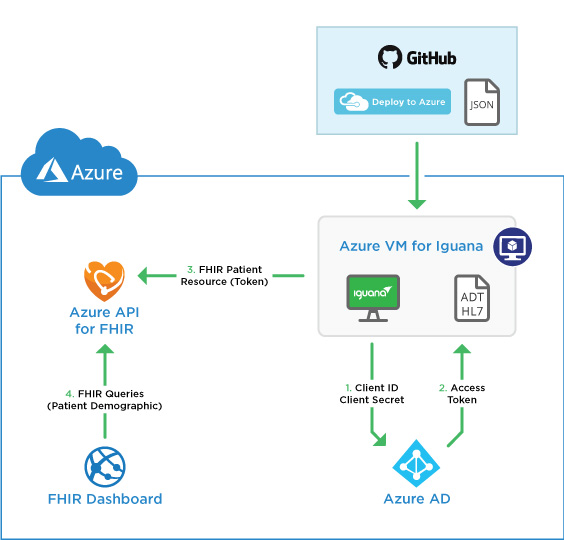
At iNTERFACEWARE, we are committed to learning the latest on all things integration including developing a deeper understanding of the Fast Healthcare Interoperability Resources standard (FHIR), engaging regularly with the HL7 community, and becoming seasoned in Application Programming Interfaces (API) interoperability. The maturation of the FHIR standard, increasing vendor API development, regulatory requirements, and the shift to value-based reimbursements all point to the fact that the market has moved past a gradual shift and has now reached a tipping point. As a result, iNTERFACEWARE has been focussed on looking forward to the future of healthcare interoperability by delivering integrated solutions that can meet the future needs of an ever-changing healthcare ecosystem. In fact, iNTERFACEWARE’s upcoming Iguana User Conference theme will focus specifically on API driven integration.
The Microsoft and iNTERFACEWARE Partnership
In January 2019, Microsoft approached iNTERFACEWARE with a proposal to participate in their Healthcare NeXT Early Access Program. Microsoft’s Healthcare NeXT is an initiative that involves collaboration with the healthcare industry’s most influential players to promote rapid healthcare innovation through artificial intelligence and cloud computing.
With market research firm IDC stating that $11.4 billion is forecasted to be spent by health-care providers on public cloud services this year, the main question Microsoft needed help answering was: How do we bring data into the cloud in a way that will accelerate machine learning for the future?
What is FHIR Server for Azure?
As mentioned on the Microsoft Azure blog, Azure API for FHIR offers exchange of data via a FHIR API and a managed Platform as a Service (PaaS) offering in Azure, designed for the management and persistence of Electronic Protected Health Information (ePHI) in the native FHIR format. The FHIR API and data store enables healthcare partners to securely connect and interact with any system that utilizes FHIR APIs.
How Does iNTERFACEWARE Fit into This Solution?
With a growing need for healthcare partners to build and maintain FHIR services that exchange and manage data in the FHIR format, Microsoft turned to our integration experts for a possible solution. The aim of the Proof of Concept (POC) was to help Microsoft gain a better understanding of the applications and technical details associated with the Azure API for FHIR, as well as how to easily send healthcare data into FHIR and the cloud. More specifically, iNTERFACEWARE would build a POC, designed to enable Microsoft’s FHIR Server to receive legacy data, such as HL7 v2 messages, from healthcare providers.
iNTERFACEWARE’s POC for Microsoft
Much like Microsoft, many healthcare organizations have developed FHIR servers in the cloud, but continue to face challenges with moving legacy healthcare data (ex. HL7v2, CDA, EDI X12, CSV) into the cloud FHIR servers. iNTERFACEWARE has therefore been hard at work developing a POC using the Iguana® Integration Engine to explore how a modern integration engine can be used to convert legacy data (ex. HL7 v2) to FHIR resources and automatically deploy the entire solution on Azure within minutes.
How it Works:
Integration Architecture
Figure 1 gives a general depiction of the integration architecture design.

Architectural Components
- Azure: Microsoft’s cloud infrastructure that hosts the HL7 to FHIR POC
- Azure AD: Azure Active Directory provides secure access to Azure API services
- Azure API for FHIR: FHIR server with data storage that provides API access
- FHIR Dashboard: Web dashboard that displays patient demographics information from the FHIR server
- Azure VM for Iguana: Azure virtual machine that hosts the Iguana application, used to convert HL7 v2 (ADT) messages to FHIR patient resources
- Azure Template on Github: Azure template that assists the user to auto-provision the Azure VM and Iguana installation
Back-end Workflow
- Iguana sends the client id and client secret to Azure AD to be authenticated
- Azure AD sends the back token to Iguana
- Iguana sends the FHIR patient resource to Azure API for FHIR
- Clinician accesses the FHIR dashboard to review Patient demographics
Front-End Workflow
When users click the “Deploy to Azure” button via Microsoft’s GitHub, it will automatically provision the Azure virtual machine and install the Iguana integration software. The FHIR adaptor within Iguana will then be used to transform and map legacy HL7 V2 messages into FHIR resources. The resources are then sent to the Azure FHIR Server where messages can be viewed on the Azure Dashboard.
iNTERFACEWARE and Microsoft Future Goals
With a successful POC completed, iNTERFACEWARE is extremely excited to be working with Microsoft to apply this concept in a clinical setting. Microsoft hopes to implement this solution in hospitals to improve clinical workflows such as patient registration. A patient registration message will typically be generated in HL7 v2 format. At this point, Iguana will automatically transform these messages, and send them to the Azure FHIR server. The messages are fully accessible on the cloud, and can then be viewed easily on the Azure dashboard for convenience and compliance. Moreover, iNTERFACEWARE’s future vision for their POC with Microsoft is to help clinicians and vendors understand how easy it is to not only connect to their cloud-enabled health care systems in this ever-changing industry but to be armed with the means to get data onto these platforms reliably and consistently — that is, by using the Iguana integration engine.
More Information
- Demonstration code on Github: https://github.com/InterfacewareCS/iguana-azure-fhir
- FHIR Client and Server
- FHIR website: https://www.hl7.org/fhir/index.html
- FHIR datatypes: https://www.hl7.org/fhir/datatypes.html
- HTTP overview: https://www.hl7.org/fhir/http.html
- Operation outcomes and server responses: https://www.hl7.org/fhir/operationoutcome.html.
- Microsoft Azure FHIR server in 5 minutes: https://docs.microsoft.com/en-us/azure/healthcare-apis/
- Microsoft FHIR Servers Sample Documentation: https://github.com/Microsoft/fhir-server-samples
